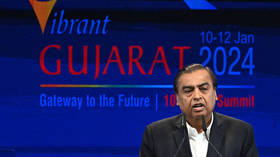India's economy is poised to grow rapidly. Will reality match expectations?

Last week the Central Statistical Office of India released official projections for gross domestic product (GDP) growth for 2023-24. It was a pleasant shock, especially given the grim circumstances facing most of the world. Economic growth, beating all expectations, is forecast at an impressive 7.3%.
A few weeks earlier the Reserve Bank of India (RBI), the country’s central bank, signaled as much during its credit policy review. Not only did RBI raise its growth forecast for the current fiscal year from 6.5% to 7%, but it also retained its projections for inflation. In other words, the central bank is confident that the acceleration in growth will not stoke another round of inflation.
Independently, Axis Bank, India’s third-largest private sector bank in terms of total assets, went a step ahead and claimed that India was transitioning to a higher growth trajectory. One that will mean the economy will expand at a trend rate of growth of 7% – as opposed to the previous average of 6%. This week of good news on the Indian economy was topped off with a year-end report released by Edelweiss Mutual Fund, arguing that this was India’s decade.
Pull all these strands together and it appears that India is on a growth highway. If indeed this rosy forecast does pan out, then it will be a gamechanger. It will, at the least, accelerate the reordering of India and help the economy reach $5 trillion by the 2030 deadline, set by the leadership.
A Happy Convergence
The reason for this remarkable uptick in optimism is the coming together of three key trends: A young demography (with two-thirds of India less than 35 years of age), the initial signs of a revival in private capital expenditure, which has been in the doldrums since 2009, and a government policy conducive to fostering business.
Clearly, it is the beginning of the cycle of private capital expenditure that is tilting the scales in the economy’s favour. So far, it is the union and state governments that have been shouldering the burden. At the end of October, their capital expenditure grew by a staggering 36.7% compared to the same period of last year.
It is undoubtedly an impressive number. However, neither is this outlay sufficient – government capital expenditure as a proportion of GDP is less than 5% – nor is it sustainable given that the exchequer is over-stretched playing defence in the aftermath of the economic shocks that struck the world after the Covid-19 pandemic.
Addressing a press conference following the presentation of the credit policy review last month, RBI defended its upward revision of the growth outlook and claimed it could be higher than forecast. Citing high-frequency economic data, the central bank’s deputy governor, Michael Patra, said, “If you look at October, November high-frequency data which we use for our nowcast, they are all very robust right now; if you just take October-November data, you will exceed 7%. So, at present, 7% is a conservative estimate.”
Backing his colleague, RBI Governor Shaktikanta Das pointed out at the same press conference that capacity utilization in manufacturing was at 74% – the level at which companies begin to invest in new capacities. “Quite a bit of investment is already taking place in private-sector manufacturing companies. For example, the investment in fixed assets by listed private manufacturing companies has registered a growth of 10.5% in the first half of the current financial year. According to our survey, the manufacturing sector is using internal reserves and surpluses to invest. They are not approaching the bank nor are they opting for any other kind of fund raising,” he added.
The Opportunity
India’s legacy of underdevelopment, wherein millions have been denied even basics like water, electricity, banking and housing, is now turning out to be an opportunity. Over the last 15 years, these deficits are being resolved. For instance, between 2005 and 2020 India lifted 415 million people out of poverty – an outcome of targeted social welfare spending delivering better bang for the buck. Similarly, in the last 10 years, the country provided banking services to 511 million people.
Measures to address these deficits are providing a stronger and deeper foundation to the consumer economy. In turn, this is proving to be a buffer at a time when global demand is shrinking, as countries struggle to stay afloat.
With most of the population playing catch-up, the Indian economy has become stratified – growing at different speeds. Analysts see this as an opportunity: pursuing premiumization with the rich and super-rich, while serving the untapped opportunity in basic needs for the largest cohort.
For example, a report by the Edelweiss Mutual Fund estimates that only a fifth of Indian households own a washing machine. With growing access to reliable power, they see increased acquisition of non-essential items such as air conditioners and refrigerators by households, expanding the consumer economy. Simultaneously, India has improved the ease of doing business and tweaked its industrial policy to incentivize manufacturing in 14 sectors using the Production Linked Incentive (PLI) scheme.
The localization of production is a strategic move to secure supply chains, and also creates the requisite skills and more jobs. Several multinational corporations have been using this route to de-risk their investments in China by creating capacity in India. In the final analysis it is apparent that the all-round optimism among key stakeholders has a basis. The big question is whether the Indian economy will match these expectations. After all it has, on several occasions in the past, flattered to only disappoint.
Where India Meets Russia – We are now on WhatsApp! Follow and share RT India in English and in Hindi
The statements, views and opinions expressed in this column are solely those of the author and do not necessarily represent those of RT.















